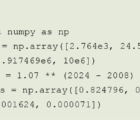The practice of adding equity to “diversity and inclusion” is becoming increasingly common.
Editor’s note: This article was originally published in The Actuary, December 2019/January 2020 edition. It is reprinted with permission from the Society of Actuaries.
As co-chairs of the new Joint Committee for Inclusion, Equity & Diversity (JCIED), we are excited for the Society of Actuaries (SOA) and Casualty Actuarial Society (CAS) to continue to work together on our common goals for the actuarial profession. The committee has begun work on several initiatives, including:
- Career encouragement for diverse students.
- Professional development programs to educate our members on DE&I topics.
- Leadership development to increase diversity in leadership in the profession and at our employers.
As we continue the hard work toward a diverse and inclusive actuarial profession, the JCIED has embraced the concept of “equity” as a core value. The practice of adding equity to “diversity and inclusion” is becoming increasingly common in nonprofit and social justice settings, but it is not often mentioned with corporate D&I efforts — possibly because the concept is not widely understood.
One helpful analogy comes from executive coach and DE&I expert Kevin Anthony Johnson:
Equity is a new addition because the old D&I lacked the intention of leveling not only the access but the opportunities. Equity represents the pay and career path inequities experienced by marginalized folks. We might be invited to the dance (diversity), and even asked to get on the dance floor (inclusion), but we get charged a two-drink minimum (less pay, higher standards, lower recognition, has nothing to do with dancing) while others aren’t. Equity says everyone pays the same cost of entry to the dance.
Equity takes D&I one step further. It promotes fair treatment and access to opportunities, while working to eliminate the institutional and unconscious barriers that limit the potential of diverse participants.
Equity is often confused with equality; however, equality doesn’t necessarily achieve the same outcomes as equity. Let’s say Jack and Jill walk up the hill and each is handed a glass of water — they’ve been treated equally, and both get to rehydrate before climbing the next hill. What if I told you, however, that Jill was forced to carry a 10-pound load up the hill and Jack was not? Perhaps she needs two glasses of water to be able to take the next step. Recognizing that these two people did not start from the same place, and providing the appropriate resources with that in mind, is equity.
Figure 1 shows a visual representation of the difference between equity and equality with a healthy “spin.” Here you can see how equality leads to a suboptimal outcome, as compared to equity.

Let’s now look at a very current and relevant example: the gender wage gap. Many actuaries believe we are a step ahead of other professions in addressing wage inequality. Because we have a credentialing system that often ties pay to the number of exams passed, there may be less evidence of a gender wage gap when comparing men and women at similar points early on in their careers. However, from our vantage point, a gender disparity still exists at the highest levels of management in the profession.
A large body of research shows there are still barriers preventing many women from reaching higher-paid leadership levels. Women across industries are systemically given fewer opportunities for stretch assignments and promotions and are less likely to have strong sponsorship or mentoring relationships within their organization. Our focus on equity will allow us to raise awareness about such barriers and take an aggressive approach toward dismantling them.
Debates around equity in insurance offerings have surfaced in recent years. One example is the recent report from the California Department of Insurance that found auto insurance discounts for affinity groups in the state “disproportionately and adversely affected drivers residing in ZIP codes with lower per capita incomes, lower levels of educational attainment and larger communities of color.”* For now, assume that affinity discounts are justified by a concentration of highly educated, highly skilled members of these organizations presenting a lower risk to the insurer. The lack of equity here stems not from insurers discriminating against low-income communities, but rather from generations of systemic discrimination and bias that have blocked these people from attaining the wealth needed to acquire higher education and skills and move into lower risk conditions.
Discounts put money back in the pockets of people with wealth, rather than in the pockets of those who could benefit the most. Applying equity in this context, we could suggest that eliminating affinity discounts and building that savings to the insurer into base rates would more equally spread the value across high- and low-income communities. Others might take it one step further and say that giving discounts to those in low-income communities, thus increasing their wealth and access to opportunities that lower their risk, would be the most equitable approach.
Time will tell where this debate ends up, but we can be sure we’ll see the push toward more equitable conditions in the workplace, as well as in the products we provide, becoming stronger and stronger over time. The JCIED is excited to be doing this hard work in our corner of the insurance industry to create a more diverse, inclusive and equitable actuarial community.
Mallika Bender, FCAS, MAAA, is a property-casualty actuary with experience in the United States and Australia. Bender’s pronouns are she/her/hers.
Sara Teppema, FSA, MAAA, FCA, is president of Alta Advisers, a health care consulting firm. Teppema’s pronouns are she/her/hers.
©2020 Society of Actuaries. Used with permission.
* Meyerowitz, Steven A. “‘Disturbing’ Disparities Found in Auto Insurance Discounts for Millions,” NU Property Casualty 360°, October 10, 2019 (accessed October 11, 2019).











